
Introduction
We’ve
tested various monitors from UK based manufacturer Hazro over the years. Now
they have decided to venture into the monitor stand market with the release of
their new EM31222 3-axis adjustable stand. The stand
offers tilt, height, rotation and swivel
adjustments and was designed by Hazro as a superior alternative to cheaper
plastic models. Build quality, sturdiness and materials are a focus here and
anodized aluminium is used throughout offering a lightweight stand, capable of
handling monitors and televisions up to 30" in size or 15kg in weight. We will
have a look at the stand, how it comes packaged and what is needed to put it al
together. We will also test its practical uses and analyse the design and
features in this review.
Note: Please click photographs in this review for
full size versions

Specifications and Features
Features of the stand
include:
-
Satisfies UL 1678 Tip
Test
-
VESA 100 x 100 and 75
x 75 compatible
-
Load Range: 0 - 15kg
(2 - 33 lbs)
-
Maximum Size of
Display: 30"
-
Elevation Range:
388mm without monitor
-
Rotation: 90° single
direction (portrait or landscape mode)
-
Swivel: 60°
(bi-direction)
-
Tilt: 105°
-
Material: Anodized
aluminium
-
Carton Dimensions:
21" x 10.6" x 4.6" (536 x 269 x 116 mm)
-
Carton Weight: 6 lbs
(3 kg)
-
Warranty: Three (3)
years
-
Retail Part Number:
EM31222 (Hazro: HZST02)
-
EAN: 0610373926533 (UPC:
610373926533)

Parts and Construction
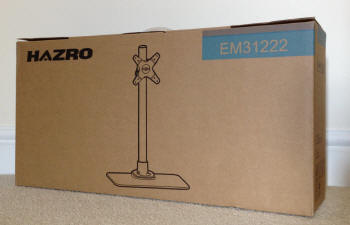
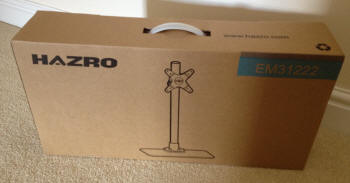
The stand comes packages in a box measuring 536 x
269 x 116 mm and is reasonably light at 3Kg. There is a carry handle for easy
transport.
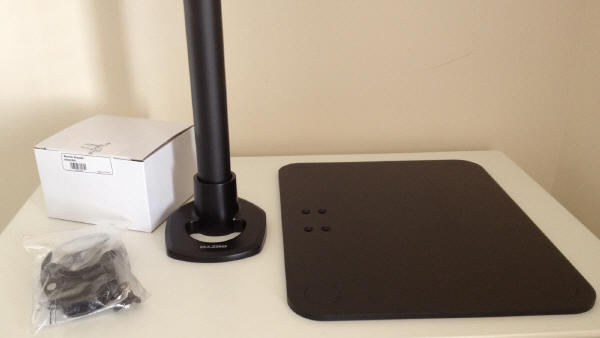
Once you open the box the parts for the stand are
in several pieces and it is the users responsibility to put it together,
following the pretty simple provided instructions.
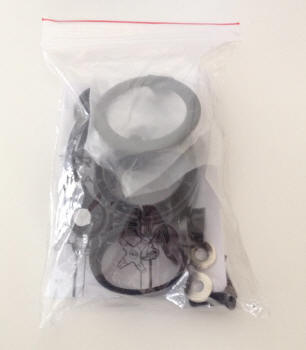
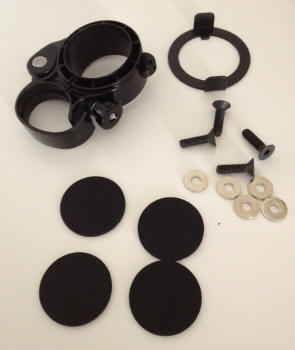
A small bag is provided with screws, washers and a
couple of parts you need for the stand when putting it together. The relevant
Allen key (M3 wrench as they call it in the instructions) is also provided.
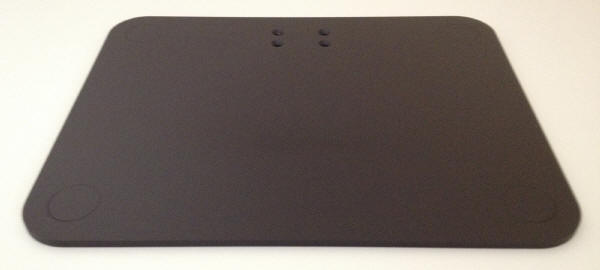
The base is the largest part of the stand
measuring 329 x 259 mm in size and being ~5.5mm thick. This is a matte black
anodized aluminium and looks pretty sleek. Some of the marketing images on
Hazro's website make it look as if the base is glossy, but in fact it's not at
all. There is no writing on the base and only 4 screw holes as shown above which
would allow you to connect and fasten the arm itself. The 4 hex screws needed
are provided of course. On the bottom of this base are 4 circular indents where
you can stick on the supplier rubber feet, to provide some cushion on your desk
and avoid slippage.
The arm then comes packaged separately and
measures ~520 mm length. It is about 37mm wide as well so is fairly thin. At the
bottom end is a rounded section which would screw into the base using the four
provided screws. This again is a matte black anodized aluminium and feels strong
and sturdy.
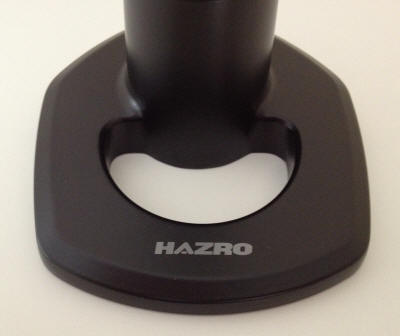
The arm has a small grey coloured ‘Hazro’ logo on
it as you can see from the photos. The arm has an indentation along the two
sides of the pole which comes into play when using the side to side swivel
function which we will talk about later.

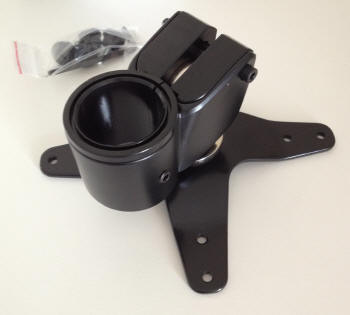
A box is provided with the main monitor bracket
enclosed, along with 4 thumb screws for connecting it to the back of your
monitor.
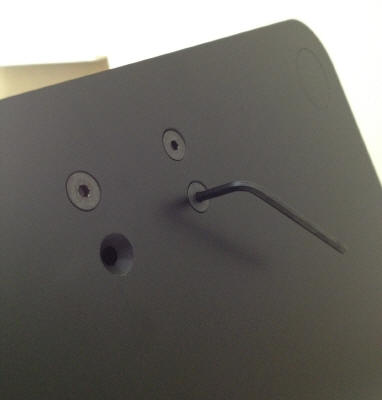
Connection of the monitor arm into the base was a
little fiddly as getting the screws lined up with the holes in the bottom of the
arm was a bit tricky. They tightened into place easily enough and provided a
secure connection between base and arm.
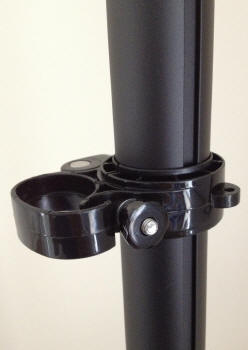
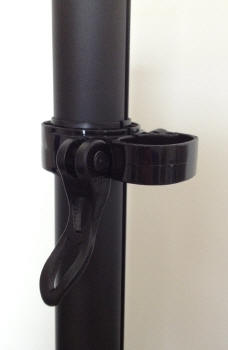
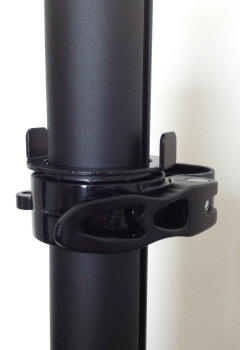
Next step is to slide the quick-release plastic
cable tidy clip onto the arm. This serves two purposes. Firstly you can use the
clip to keep the cables tied nicely out the way and hidden as much as possible
behind the thin arm. Secondly it can be tightened and locked into place using
the quick release catch which is shown above. This then acts as the height
adjustment for the screen, with the monitor bracket not being able to move lower
than this is tightened. This bracket is the only plastic part of the main stand.
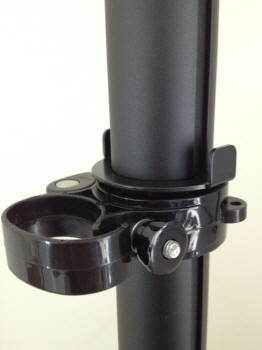
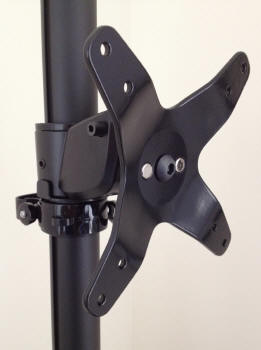
A small metal ‘swivel lock ring’ disc is then
placed on top of that quick-release cable tidy section as shown on the left hand
photo above. It has two teeth on it, one on each side. These will mean that once
the screen is sat on top of the cable tidy section, it cannot be swivelled too
far side to side.
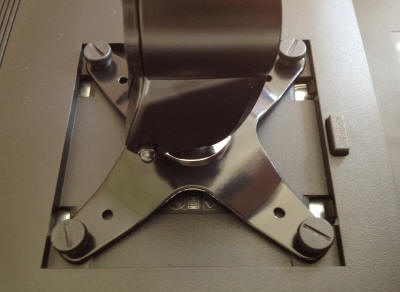
The monitor bracket itself must be attached to the
back of your screen first. This is easily achieved using the provided 4x thumb
screws, with no need for a tool or Allen key. Here we have attached the bracket
to the back of a
Dell U2713HM 27” monitor (VESA 100mm). This weighs 5.6Kg incidentally so
should be well within the capabilities of the stand.
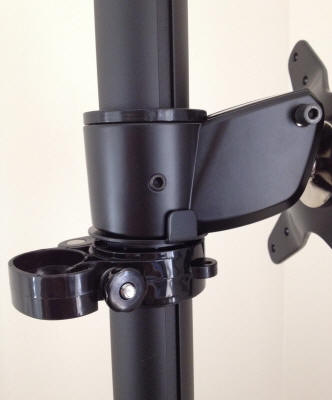
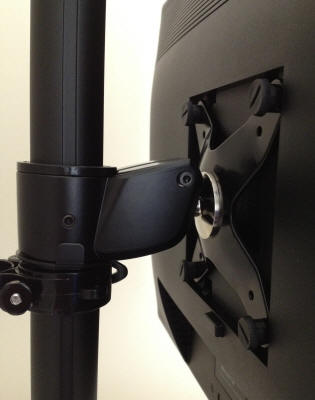
Once connected to the back of the screen you slide
the bracket onto the arm. It will then stop at the cable tidy which is tightened
and fastened at your chosen height. You will see from the first image above that
the swivel lock ring stops the monitor bracket from turning too far side to
side.
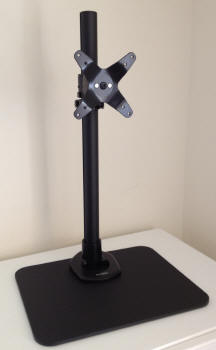
Above: the completed stand







Above: various marketing images provided by Hazro

Adjustments
In terms of ergonomic adjustments we tested each
feature to establish how easy they were to use, what range of adjustment they
offered and how useable they are ultimately for moving your monitor around.
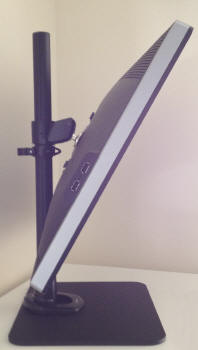
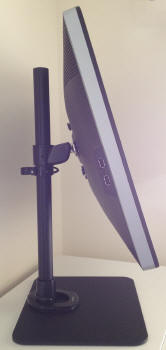
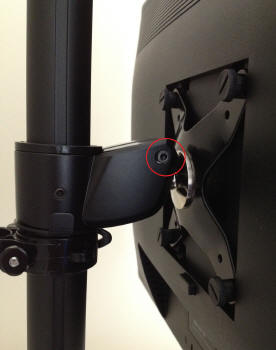
The tilt range offered is massive and the
manufacturer specifies a 105° range. The screen can tilt a long way downwards as
shown above, which is probably mostly unnecessary for a normal user. It can
thankfully also tilt a pretty reasonable way backwards as shown, and so should
offer a decent range of adjustment for any angle of view.
The one issue with the tilt function is that it
must be manually tightened using the Allen key and a small screw on the side of
the monitor bracket (as circled in red on the right hand photo). Every time you
move the tilt angle you must then re-tighten this screw to hold it in place,
otherwise the screen sags downwards. It was fine obtaining a tightness which
would hold the U2713HM in place, although I’m not sure whether it would have
trouble with really heavy screens or not as really this is quite a light monitor
(5.6Kg). While it is possible to avoid the sag of the screen and tighten it to a
satisfactory level, it does create an issue with flexibility for the user as
it’s quite fiddly then to re-position the screen each time, especially if you
have the need to move the tilt regularly. Smoothness of the movement was good,
but its ease obviously depends on how tightly you’ve done up the fastening
screw.
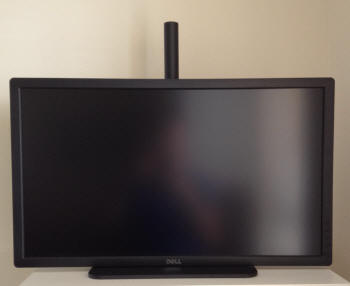
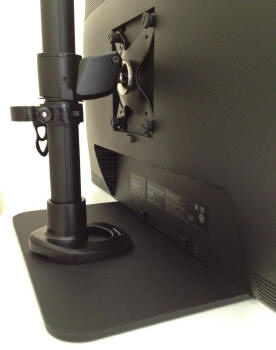
The height adjustment offers a massive range of
adjustment as well, with 388 mm of movement possible. It will be possible to
bring the height of any screen down so that it is touching the top of the base,
and therefore only being ~5.5mm from the top of the desk as shown above. How low
the bracket needs to move down the stand at the back depends obviously on the
dimensions of the screen and the location of the VESA mounting holes on its
back. It was good to see a full adjustment range possible though down to a
minimum setting like this. The only problem of course with moving the screen all
the way down to a minimum height was that the arm could then be seen above the
top of the monitor as shown above, even on a screen as big as this 27” U2713HM.
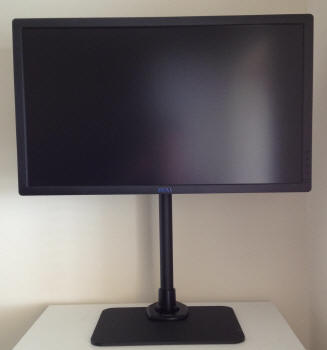
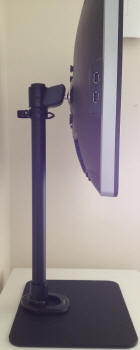
At the top of the 388mm adjustment the screen is
then very high above the level of the desk as you can see above. The height of
the screen above the desk again depends on the dimensions of the screen being
used but I’m sure this should provide enough height adjustment for any user.
Even at the highest setting the arm remained very stable which was great news.
Again there is an issue however with the height
adjustment. It’s actually quite hard to move the height up and down on the arm
and you really need to get access to the bracket and force it up or down with
two hands. You also need to be trying to unfasten and slide the cable tidy clip
to allow you to move it up or down more, and so all in all its quite tricky to
do. The weight that the screen puts on the bracket means it doesn’t slide
smoothly up or down and it is pretty difficult to manoeuvre. The cable tidy clip
does a good job of fastening the screen at a certain height though thankfully.
Again you wouldn’t want to be trying to change the height very often or it could
become difficult.
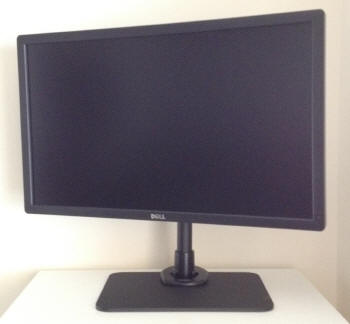
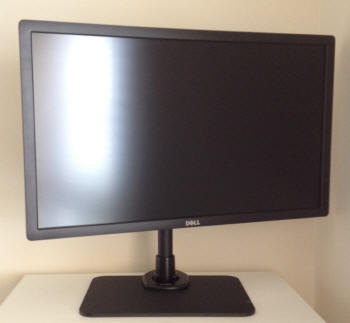
The side to side pivot adjustment is thankfully
easy to use and offers smooth adjustments. It is limited by the small swivel
lock ring and the maximum range it allows is shown above which isn't that far.
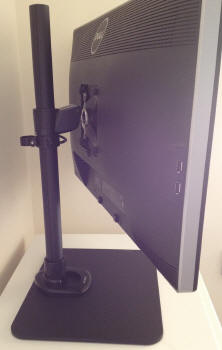
You can of course remove that ring if you want,
although there is then the risk that if you swivel the screen too far, the whole
thing could topple over and probably damage the screen and stand. Maximum swivel
adjustment is again shown in the photo above, from behind.
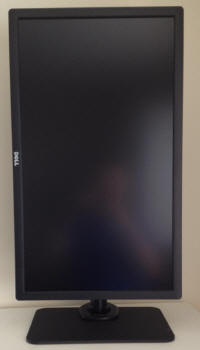
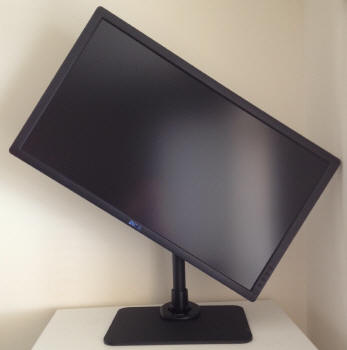
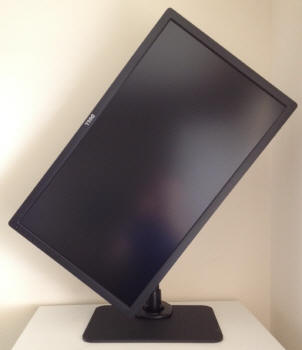
The rotation function is very easy to use. The
screen can be simply and smoothly rotated 360° if you want in a full circle.
There is no ‘locking’ of the screen at certain orientations so you need to level
it yourself, which is easy enough to do by eye. You can rotate the screen round
as far as you want as shown above.
A summary of the stands ergonomic adjustments
is shown below:
|
Function |
Range |
Smoothness |
Ease of Use |
|
Tilt |
105° |
Smooth |
Difficult to adjust, tightening of screw
needed to avoid screen sag. Not flexible for regular adjustment |
|
Height |
388mm |
Very Stiff |
Difficult to move due to weight of screen, need access to the bracket and
two hands. Not practical for regular adjustments |
|
Swivel |
60°
total |
Smooth |
Easy although not massive range |
|
Rotate |
360° |
Smooth |
Easy to use and great range |

Conclusion
The ergonomic adjustments left us with mixed views
to be honest. In my opinion the two most useful features of any stand are the
tilt and height adjustment, likely to be most used and most altered by your
average user. The tilt and height here did offer a massive range of adjustment
and so it was very easy to get a comfortable position and angle for a wide
variety of conditions and uses. Range was good, although practicality was not in
my opinion. The tilt needed to be fastened tightly using the hex key and
fastening screw and this was particularly important with heavier screens. This
means it is not really very useable as an adjustment day to day as you have to
keep loosening and tightening that screw and making sure the screen is tight
enough so as not to sag. It's fine to get a comfortable position and angle, you
just don't really want to be moving it around much after that. Again the height
range was massive and should be more than adequate for most users. The screen
was very sturdy, even at the maximum height and the stand was clearly strong and
stable. However again, practically it was not the best. It was quite hard to
re-position the screen, and the mechanism and movement using the cable tidy clip
made it hard work. Like the tilt, it's easy to get a good height and position
but you wouldn't want to be trying to move it up and down much day to day.
The other adjustments of swivel and rotation were
much easier to use thankfully. The side to side swivel was smooth and easy
although didn't offer a massive range. Rotation was easy and could be turned all
the way around if you really wanted to. The stand did seem better equipped to
handle swivel and rotate than it did for tilt and height.
The appearance of the stand was very nice and the
anodized aluminium design was attractive. Materials were of a very high quality
and the stand seemed very strong and sturdy which is of course a necessity for a
decent stand. The stand retails for ~Ł80 GBP at the moment in the UK. It's
certainly a high quality product with expensive and strong materials being used.
If you aren't going to need to change your tilt or height position much then it
provides a decent option as a widely adjustable and versatile stand. If you need
to reposition the monitor a lot for different viewing angles then the
inflexibility of those features may prove a little frustrating.
|
Pros |
Cons |
|
High quality materials and
aluminium design |
Tilt range is very good, but
impractical for regular adjustments due to tightening screw mechanism |
|
Sturdy and strong |
Height range excellent but
impractical to move regularly due to difficult movement |
|
Swivel and rotate easy to use |
Swivel range perhaps a little
limited |
|
 |
If you have enjoyed
this review and found it useful, please consider making a
small
donation to the site. |